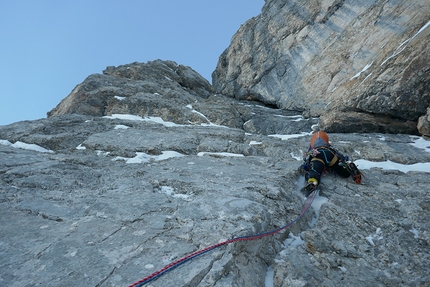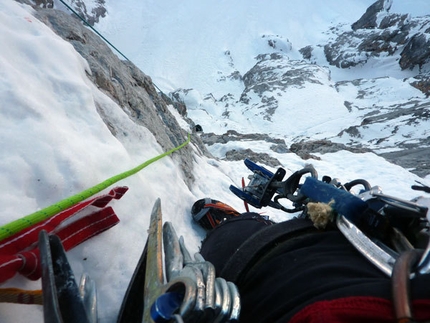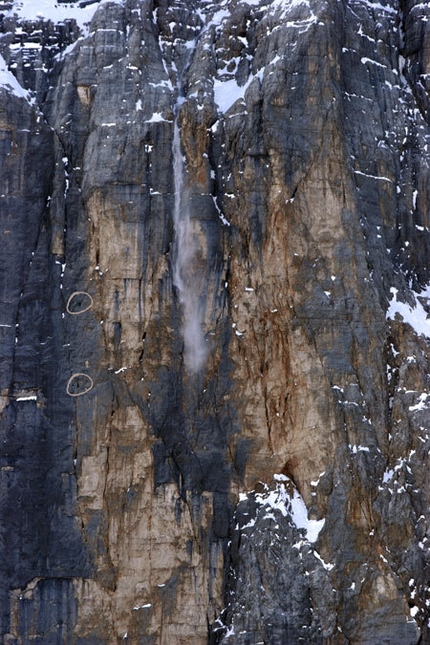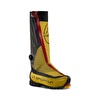Dolomites: French winter ascent of Civetta Solleder climb

 1 / 18
1 / 18 Groupe militaire de haute montagne
Groupe militaire de haute montagne
From 22 - 25 December 2017 the French alpinists Léo Billon and Max Bonniot belonging to the elite Chamonix-based Groupe militaire de haute montagne and mountain guide Benjamin Védrines made an important winter repeat Via Solleder up the North-West Face of Civetta in the Italian Dolomites. Established by the formidable climbers Emil Solleder and Gustav Lettenbauer in just 15 hours on 7 August 1925 and famous for being the first grade VI rock climb in the Alps, these nigh 1200 meters were climbed alone for the first time in September 1952 by Cesare Maestri. The first winter ascent was carried out from 28 February to 7 March 1963 by Ignazio Piussi, Giorgio Radaelli and Toni Hiebeler, while a few days later Roberto Sorgato, Natalino Menegus and Marcello Bonafede followed in their cold footsteps. From 14 to 18 January 2000 30-year-old Marco Anghileri made the first winter solo ascent of the route, accomplishing an absolute masterstroke on one the the biggest and most important walls in the Dolomites. At the end of 2017 the French climbers decided to spend their Christmas up on this extraordinary wall and, in remembering Anghilieri’s ascent 17 years ago, experienced the adventure they had been looking for so close to home.
Max congratulations. First of all, why did you choose this route in particular?
Because it was the easiest on the entire face! Also because it seemed so logical and it’s a historical climb. It is a pure direct line that goes straight to the summit. We also believed we’d easily find some good bivy sites where we would be able to lie down and sleep, instead of spending the night sitting in our harnesses. As it turned out, the bivouac sites were ideal and we spent 3 perfect nights in the face.
Can you tell us a bit about the ascent?
We knew it was going to be good training, dealing with 4 days of this style of climbing: chimneys and slabs that become quite complicated in winter even if they are merely grade IV or V in summer! There was snow every were, sometimes huge mushrooms where we had to dig deep in order to find the pitons! Climbing limestone is always really interesting and helps you improve your technical abilities and climbing skills because it is hard to read and quite difficult to protect. Climbing limestone with crampons is always a funny game because there aren’t as many continuous cracks as on granite. You have to commit yourself a bit more and the route finding is always more complicated than on granite.
What did you know about the climb?
That it was the first grade VI climb in the Alps! We knew it was going to be an adventure because of the stories we had heard from the several previous winter ascents! Like the first one in 1963 with Ignacio Piussi, "The strongest climber of his era" as captioned in a picture published in an old Vertical magazine. We had also read Patrick Berhault’s point of view about the Solleder route, in his chapter about this climb entitled "La concentration c'est la sécurité" which states it is a "Demanding route because of the large number of pitches with loose rock and poor protection". So it was with big respect for what was achieved in the past that we decided to dig deep into Civetta in winter! We wanted a good adventure and weren’t disappointed!
So you didn’t know the climb. What about Civetta in general?
For Benjamin it was his second time on the summit of Civetta. He had done the Via Ferrata degli Alleghesi with his girlfriend few years ago. None of us had previously climbed the NW Face though. And now we are really motivated to come back in summer to climb routes like Nuvole barocche or Chimera verticale.
A new experience
Yes! When you don't now the range it’s always really interesting to examine the approach and also to find the best way back down. As I said, we didn’t know anything with the Civetta group so everything was a discovery for Leo and for myself. And even if Benjamin had ascended Civetta in summer, the problems you’re faced with in winter are quiet different. There’s the risks of avalanches, and it’s also difficult to find the right descent from the summit. Even if there is a via ferrata, it would have been easy to lose the way with all that snow and as things turned out the descent proved quite interesting! It was alo interesting for us to leave the Chamonix range where we often climb in winter. In Civetta, we had to deal with many more logistical questions than when we climb the Grandes Jorasses for instance. And this is exactly what we were looking for on this trip to the Dolomites!!
What was it like up on the face?
Really cool, because we were alone on the face but we could hear the hustle and bustle from Alleghe down below, especially at Christmas! It was cool to hear the music while eating our dehydrated meals on 24th! The actual climbing was really intense because there are not very many easy pitches. Often the climbing is complicated, like the Lettenbauer chimneys on the first half of the climb. On one particular pitch you cannot climb with your backpacks because the chimney is simply too narrow. With our big packs, we had to haul them. Climbing this route in winter is made up of lots of small details and you have to think twice before doing anything. This is exactly the sort of adventure we were after.
Right in the heart of the Dolomites
Yes. It was really nice to experience an adventure like this in the Alps. Expeditions can sometimes be rather boring because they often take really long. In winter adventures in the Alps become extremely intense and they are easy to get to. Whenever I climb in winter in the Alps, I see no tracks at the Bergshrund, nobody is ever on the face. I really like this feeling of loneliness, so close to big towns like Chamonix or Grindelwald for example.
A final thought Max…
I really liked the Italians we met, so friendly! When we descended from the summit we found a small sheet of paper on our car. Contrary to Chamonix it wasn’t a fine!! It was written by Valter Bellenzier, the hut warden at Rifugio Tissi. He’d seen us up on the mountain, he knew exactly what route we’d climbed. We called him in order to drink a glass of beer together and talked about the face, about all those people who’d climbed there like Marco Anghileri, a friend of Valter and his wife Paola. It was a really nice moment. The Italians really know how to make their guests feel welcome!



 Copia link
Copia link













 See all photos
See all photos


























